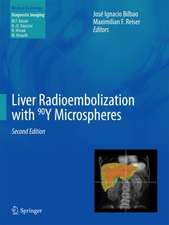Targeted Radionuclide Tumor Therapy: Biological Aspects
Editat de Torgny Stigbrand, Jorgen Carlsson, Gregory P. Adamsen Limba Engleză Paperback – 19 oct 2010
| Toate formatele și edițiile | Preț | Express |
|---|---|---|
| Paperback (1) | 1225.67 lei 38-44 zile | |
| SPRINGER NETHERLANDS – 19 oct 2010 | 1225.67 lei 38-44 zile | |
| Hardback (1) | 1425.76 lei 43-57 zile | |
| SPRINGER NETHERLANDS – 11 sep 2008 | 1425.76 lei 43-57 zile |
Preț: 1225.67 lei
Preț vechi: 1290.18 lei
-5% Nou
Puncte Express: 1839
Preț estimativ în valută:
234.56€ • 243.98$ • 193.64£
234.56€ • 243.98$ • 193.64£
Carte tipărită la comandă
Livrare economică 09-15 aprilie
Preluare comenzi: 021 569.72.76
Specificații
ISBN-13: 9789048179565
ISBN-10: 9048179564
Pagini: 416
Ilustrații: XIV, 402 p. 53 illus., 15 illus. in color.
Dimensiuni: 155 x 235 x 25 mm
Ediția:Softcover reprint of hardcover 1st ed. 2008
Editura: SPRINGER NETHERLANDS
Colecția Springer
Locul publicării:Dordrecht, Netherlands
ISBN-10: 9048179564
Pagini: 416
Ilustrații: XIV, 402 p. 53 illus., 15 illus. in color.
Dimensiuni: 155 x 235 x 25 mm
Ediția:Softcover reprint of hardcover 1st ed. 2008
Editura: SPRINGER NETHERLANDS
Colecția Springer
Locul publicării:Dordrecht, Netherlands
Public țintă
ResearchCuprins
to Radionuclide Therapy.- Therapeutically Used Targeted Antigens in Radioimmunotherapy.- EGFR-Family Expression and Implications for Targeted Radionuclide Therapy.- Targeting Tumours with Radiolabeled Antibodies.- Antibody Fragments Produced by Recombinant and Proteolytic Methods.- Novel Alternative Scaffolds and Their Potential Use for Tumor Targeted Radionuclide Therapy.- Peptides for Radionuclide Therapy.- Choice of Radionuclides and Radiolabelling Techniques.- High-LET-Emitting Radionuclides for Cancer Therapy.- Targeted High-LET Therapy of Bone Metastases.- The Auger Effect in Molecular Targeting Therapy.- Radiation Induced Cell Deaths.- Radiation Induced DNA-Damage/Repair and Associated Signaling Pathways.- Radiation Induced DNA Damage Checkpoints.- Cancer Stem Cells and Radiation.- Effects of Low Dose-Rate Radiation on Cellular Survival.- Bystander Effects and Radionuclide Therapy.- Enhancing the Efficiency of Targeted Radionuclide Therapy.- Low Dose Hyper-Radiosensitivity: A Historical Perspective.- Clinical Radionuclide Therapy.- Developmental Trends in Targeted Radionuclide Therapy: Biological Aspects.
Recenzii
From the reviews:
"This book is devoted to understanding the biological aspects of targeted radiotherapy and discusses in depth the various targeting agents as well as the radiopharmaceuticals used in targeted therapy. … Physicians, physicians in training, and physicists who use radionuclide targeted agents in the specialties of radiation oncology, medical oncology, and nuclear medicine are the intended audience. … Overall this is a very informative book for physicians particularly interested in the biological aspects of targeted radiotherapy." (James G. Douglas, Doody’s Review Service, November, 2009)
"This book is devoted to understanding the biological aspects of targeted radiotherapy and discusses in depth the various targeting agents as well as the radiopharmaceuticals used in targeted therapy. … Physicians, physicians in training, and physicists who use radionuclide targeted agents in the specialties of radiation oncology, medical oncology, and nuclear medicine are the intended audience. … Overall this is a very informative book for physicians particularly interested in the biological aspects of targeted radiotherapy." (James G. Douglas, Doody’s Review Service, November, 2009)
Textul de pe ultima copertă
The last three decades have provided opportunities to explore the potential of treating malignant diseases with antibodies or other targeting molecules labelled with nuclides. The expanding array of new targeting molecules (recombinant antibodies or peptides) may increase the therapeutic efficacy. The title of this book "Targeted Radionuclide Tumor Therapy – Biological aspects" was selected to reinforce the concept that a major focus was devoted to understanding the biological effects of targeting and radiation. Furthermore, our rapidly expanding knowledge of low dose-rate effects, different types of cell death, autosensitization and the increasingly likely existence of cancer stem cells suggests to us that even more efficient approaches in targeting might be possible in the future.
The development of targeted therapy is a true multidisciplinary enterprise involving physician scientists from the fields of nuclear medicine, radiation therapy, diagnostic radiology, surgery, gynaecology, pathology and medical oncology/haematology. It also involves many preclinical scientists working with experimental animal models, immunochemistry, recombinant antibody technologies, radiochemistry, radiation physics and basic cell biology.
It is the ambition of the editors to enable deeper insights in the process of improving targeted therapy. We believe that the time now has come when targeted therapy can soon be added to standard oncology treatment regimens.
The development of targeted therapy is a true multidisciplinary enterprise involving physician scientists from the fields of nuclear medicine, radiation therapy, diagnostic radiology, surgery, gynaecology, pathology and medical oncology/haematology. It also involves many preclinical scientists working with experimental animal models, immunochemistry, recombinant antibody technologies, radiochemistry, radiation physics and basic cell biology.
It is the ambition of the editors to enable deeper insights in the process of improving targeted therapy. We believe that the time now has come when targeted therapy can soon be added to standard oncology treatment regimens.
Caracteristici
Focus on biological effects of targeted radionuclide therapy Comprehensive presentation of different mechanisms of tumor cell death Up-to-date presentation of new targeting agents Summaries of present state of clinical applications of targeted therapy Introduction of the new concept; Autosensitization during radionuclide therapy








